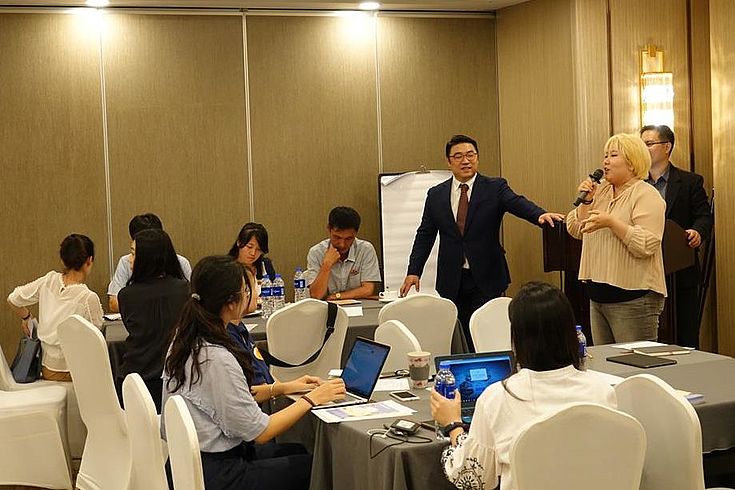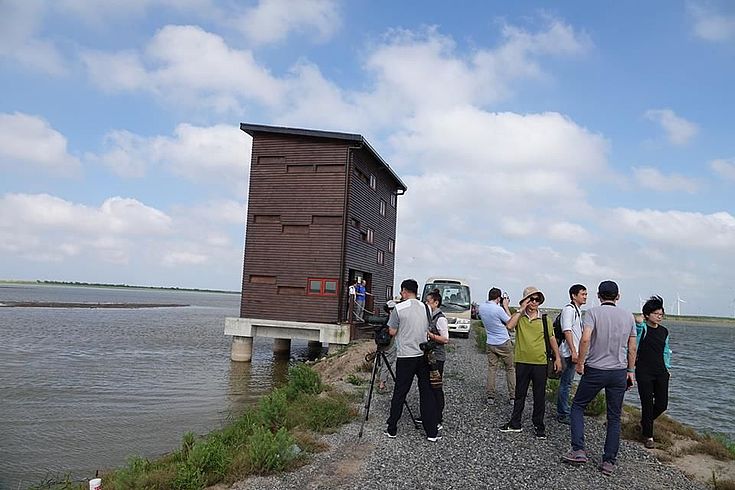Subregional Training
Wetland Management for Site Managers of the Yellow / West Sea
Mr Suh Seung Oh, Executive Director of the Ramsar Regional Centre – East Asia opening the workshop
HSF
Importance of regional cooperation for the improvement of environmental protection along the Yellow Sea / West Sea
Among other efforts, a working group on the Conservation of the Yellow/West Sea Intertidal and associated coastal Wetlands has been created and met on 9 July 2018 for the first time. HSF Korea actively supports these efforts and regional cooperation in Northeast Asia. Directly after the group meeting which focused on the improvement of coordination of the conservation efforts in the region, a training for wetland managers was launched to improve capacities on the local level. The training lasted from 10 – 13 July 2018. HSF Korea supported the participation of a delegation from DPR Korea.
Mr Suh Seung Oh, Executive Director of the Ramsar Regional Centre – East Asia opened the workshop with his remarks stressing the importance of regional cooperation on all levels to improve the conservation of the environment along the Yellow / West Sea. The first session focused on transboundary cooperation. While Sangjin Lee of the Yellow Sea Large Marine Ecosystem (YSLME) Project introduced an ongoing project in the region targeting maritime biodiversity and ecosystem services, Jens Enemark of the Wadden Sea Transboundary Ramsar Site introduced a case from Europe that is highly relevant as a model for current efforts in Northeast Asia.
Hanns Seidel Foundation and East Asian - Australasian Flyway Partnership cooperate to protect wetlands
HSF
Activities of Hanns Seidel Foundation Korea in wetland protection and biodiversity
The second session with the title “Activities in the Yellow/West Sea” started with a presentation by Mr Felix Glenk, Project Manager for DPR Korea of the Hanns Seidel Foundation. He introduced the activities of the Foundation and many joint partners in the field of wetlands and biodiversity conservation. Since the National Workshop in Pyongyang in 2015, the Foundation has supported dozens of biodiversity surveys, trainings, workshops and regional conferences to support the integration of the DPR Korea into the international environment network. This contributed to the accession of the country to the Ramsar Convention and the East Asian – Australasian Flyway Partnership in 2018. Two close partners of HSF Korea in this project, Dr Lew Young of EAAFP and Mr Raphael Glemet of IUCN, subsequently added the perspectives of their organizations, emphasizing the significance of international networks for a successful environment conservation.
HSF Korea supported the participation of a delegation from DPR Korea
HSF
Communication, Capacity Building and Raising Awareness
The third session then ensued with presentations by Mr Yamme Leung, Director of Education of the World Wide Fund for Nature (WWF) - Hong Kong on communication, capacity building, education, participation and awareness raising. Lew Young then explained to the audience how to update the information sheet for Ramsar Wetlands. Raphael Glemet introduced the Ramsar Site Management Effectiveness Tracking Tool. On the second day of the workshop Robert McInnes, Director of RM Wetlands, was invited to introduce and train the site-managers on the Rapid Assessment of Wetland Ecosystem Services (RAWES). The tool is an approach for site managers and the local population to better understand and analyze the ecosystem services that wetlands provide, e.g. the provision of fresh water, food, fibre and fuel, or the regulation of local and global climate as well as air quality.
Bird observation point directly on the shore of the site where the Yangtze River flows into the Yellow Sea
HSF
Field Trip to Chongmin Dongtan Nature Reserve and to the Jangtze Estuary
A field trip then brought the audience to the Chongming Dongtan Nature Reserve. During a visit to the local wetland center the site was introduced to the international participants. The Ramsar Wetland site is internationally important and works closely with WWF China and other international environment organization to preserve the important habitat for birds, the services that it provides for the local population in the area, and to use the site as a hub for education and awareness raising. The group later visited a bird observation point directly on the shore of the site where the Yangtze River flows into the Yellow Sea. It is this estuary that serves as a stop-over and resting site for many different species. Lastly, the delegates visited a project implemented by WWF China and discovered another impressive part of the wetland site. The last day served as a day for information sharing and the introduction of main challenges of Ramsar Sites along the Yellow / West Sea before the participants returned to their home destinations.




